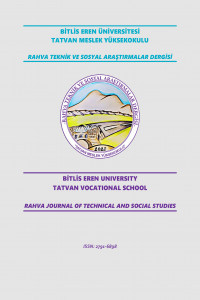Kazakistan Cumhuriyeti'nin Emeklilik Fon Sistemindeki Yatirimlari Yönetme ve Geliştirme Metodları
Küresel pazarda yaşanan mevcut değişimler ve ekonomik çalkantılar Kazakistan ekonomisi içinde bir takım önemli sonuçlar doğurmaktadır. Emeklilik sistemi tüm dünyada olduğu gibi Kazakistan cumhuriyetinin sosyo-ekonomik sisteminin içerinde sürekli gelişen dinamiklerinden biridir. Buna rağmen dokuz yılı aşkın bir süredir faaliyette olan birikimli emeklilik sisteminin de sorunları var. Bu nedenle emeklilik sisteminin desteklenmesi ve geliştirilmesi Kazakistan'ın ekonomi politikasının önceliklerinden birisidir. Birikimli emeklilik sistemi, emeklilik ödemelerinin kaynağı bireysel emeklilik hesaplarında biriken fonlar olacağından, ilgili vatandaşları emeklilikten sonraki gelir düzeyinden sorumlu olmaya zorlamaktadır. Bu nedenle, mevduat sahibi fondan mevduata ilişkin gelirin, ortalama piyasa oranlarından düşük olmamak üzere şahsi hesabına aktarılmasını da talep edebilmektedir. Aksi takdirde, FDIC tarafından hesaplanan ortalama piyasa oranlarına ve seçilen fonun sonuçlarına uygun ödenmelidir. Sistemin değişmesinin bir diğer önemli nedeni ise Kazakistan'da çalışan insan sayısının her yıl azalması; ayrıca doğum oranının bundan sonra düşmesi beklenmektedir. Bu durum ise; emekli maaşı almaya hak kazanan kişi sayısının artacağı ve kendileri için katkı payı ödeyen işçi sayısının azalacağı anlamına gelmektedir. Böyle bir durumda emeklilik sistemi sürdürülebilirliği kaybedebilir. Bir emeklilik fonunun etkili olabilmesi için, katkı paylarının yüksek oranda olması gerekmektedir. Fonların mali durumunu ve karlılığını etkileyen temel göstergelerden biri, emeklilik varlıklarının yatırım getirisi veya maksimum komisyon katkı payı tutarlarıdır.
Anahtar Kelimeler:
Asset, Contribution, Economic Policy, Finances, Funds, Income, Investment, Pension, Pension System, Supervision.
Methods Of Managing And Improving Investments In The Funding Pension System Of The Republic Of Kazakhstan
The current changes and turmoil in the global market have a number of significant consequences for our country's economy. The pension system is one of the dynamically developing sectors of the socio-economic system of the republic. Despite this, the cumulative pension system, which has been in operation for more than nine years, has its problems. Therefore, support and development of the pension system is one of the priorities of Kazakhstan's economic policy. All types of changes are social and economic issues that require proper regulation by the state. The accumulative pension system obliges the citizens involved to be responsible for the level of their income after retirement, since the source of pension payments will be the funds accumulated in their personal pension account.
The depositor can also demand that the fund transfer the income on the financial deposit to his personal account in an amount not lower than the average market rates. And if not, one should take an interest in the average market rates as calculated by the FDIC and the results of the selected fund. Another important reason for changing the system is that the number of working people in Kazakhstan is decreasing every year; in addition, the birth rate is expected to decrease from now on. This means that the number of people eligible to receive a pension will increase, and the number of workers who pay contributions for themselves will decrease. The Cooperation system cannot provide a continuous pension in such a case. For a pension fund to be effective, the number of contributors must be large. One of the main indicators that affect the financial condition and profitability of funds is the return on investment of pension assets and the maximum amount of commission contributions.
Keywords:
Asset, Contribution, Economic Policy, Finances, Funds, Income, Investment, Pension, Pension System, Supervision.,
___
- N.A.Nazarbayev, (2012) Address by the President of the Republic of Kazakhstan.
- Alibayev A. (1999 ) “About some moments of the first year of the pension reform”// Kazakhstan stock market--No3.
- Amanzholov S. (1999 )“Chilean model” made roots on the Kazakhstani land.//Zangazeti- February 24.
- Abenova Zh. (2001) “Under the sauce of Chile: Pension funds go under South American way ”// Izvestiya, No 29.
- “About pension supply in the Republic of Kazakhstan” (1997) No 136-1 (ed.11.06.2004).
- Iskakov U.M., Bokhayev D.T., Ruziyeva E.A. (2005), Finance markets and mediators: Textbook.- Almaty: Economics,p.298.
- Valiyev K.(2006), Voluntary professional pension contributions- myth and reality// Labour in Kazakhstan: problems, facts, comments.-No 7 p.32-34.
- Zholdasbaev. S., (2005), “The system of compulsory social insurance is an additional form of social protection of the population.”//Labor in Kazakhstan: problems, facts, comments, р.6-10 .
- Abdykalykova. G., (2004), Again about pensions // Labor in Kazakhstan: problems, facts, comments, р 24-29.
- Kan M.(2006), Organization of pension supply (from the world experience) // A man and labour- No 5.- p.29-33.
- Indicators of the fund's pension assets as of (2020),(01.10.2022) on an accrual basis from the beginning of the year, in thousands of tenge https://www.enpf.kz/ru/indicators/pa/current.php.
- Askarov T.(2002), “Economic decay is useful for future depositors” //Respublika. No 9.
- Mityugina, G. (2008),New system of pension payments transferring // Labour-Salary-Pension in Kazakhstan-No 9-p.15-18.
- Krivoshchyokova, E., (2006), Compulsory pension insurance : theory and practice of Russian pension reform// Issues of Economics-No 6. p.120-136.
- Tulepbaev, M., (2003), "Kazakhstani pension reform is in a stalemate"//Labor in Kazakhstan, р 32.
- Başlangıç: 2021
- Yayıncı: Bitlis Eren Üniversitesi
Sayıdaki Diğer Makaleler
SHMYO Öğrencilerinin Dijital Teknoloji İle İlişkileri ve Bağımlılık Durumları
Yazılım Tanımlı Radyoya Dayalı RF Parmak İzi Toplamak için Düşük Maliyetli Bir Çözüm
Hüseyin PARMAKSIZ, Cihan KARAKUZU
Kazakistan Cumhuriyeti'nin Emeklilik Fon Sistemindeki Yatirimlari Yönetme ve Geliştirme Metodları
